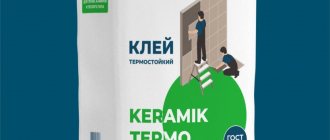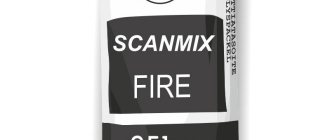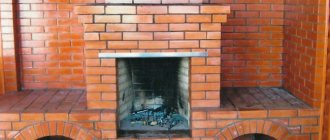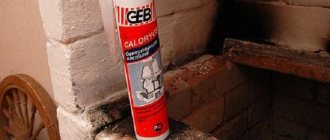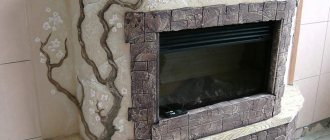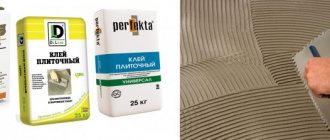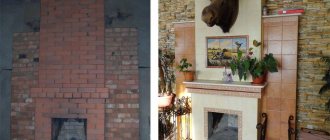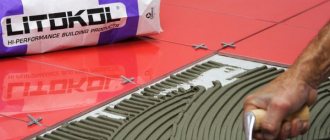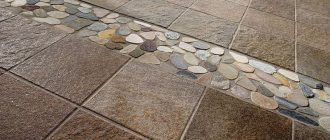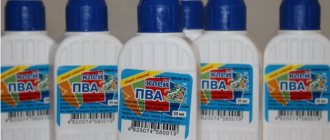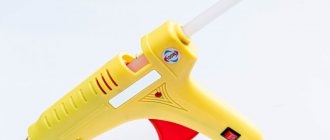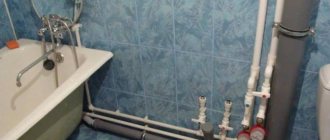The laying of fireplaces and stoves has a number of features, because the structure will be constantly exposed to high temperatures. In this regard, for the process you need to choose a special glue for stoves and fireplaces; it will help preserve the structure and will not collapse or crack in such conditions. More details about what properties a high-quality fire-resistant adhesive should have and what types exist will be discussed below.
Characteristics of heat-resistant adhesive
Thanks to its special, unique composition, hot melt adhesive differs from all others. Let's look at the main ones:
- Resistance to temperature changes is a rather important point. As already mentioned, this adhesive substance is used for lining fireplaces and stoves, so temperature changes cannot be avoided here.
- Fire resistance - the adhesive creates a barrier between the tiles and the fireplace (stove or floor).
- Elasticity - if the substance is elastic, that is, it will be convenient to apply it to the tiles or even level the surface with it.
- Moisture resistance is an excellent option for baths.
Installation work
One of the most important indicators of tile adhesive is density, compressive strength and the degree of its shrinkage. For such properties, GOST establishes acceptable standards and rules for working with glue.
In order to maintain the quality characteristics of the heat-resistant adhesive composition, it is important to correctly determine the volume and consumption of the mixture for the treated area.
To obtain reliable hold of tiles of different sizes and weights, it is necessary that the surface of the structure is smooth, dry, and free of dirt. The preparation of the adhesive solution must be carried out in compliance with the basic rules:
- the temperature of the environment and the base should not be lower than + 5 ℃ and exceed + 25 ℃;
- For kneading, plastic utensils, a trowel and a drill with a special attachment are used;
- The water for mixing should be clean and at room temperature.
The powdered product is poured into water in the correctly calculated proportion indicated on the packaging and thoroughly stirred until smooth. The prepared solution is applied to the base only with a notched trowel.
The unique invention allows you to apply the required layer of heat-resistant adhesive evenly and with minimal consumption. The size of the tool is selected taking into account the thickness of the mortar and the tile itself.
You can verify the correct consistency of the mixture by first gluing the tiles for testing. The working life of the solution is usually from 2 to 3 hours.
The position of the tile is adjusted within a few minutes after applying the mixture to the surface. It is important here to prevent air from accumulating. Excess substance at the joints and drops on the tiles are immediately removed from the hardening area with a clean, even spatula.
Types of heat-resistant glue
There are two main types of temperature-resistant adhesives.
They all differ in composition:
- For stoves and fireplaces - since operation occurs above 1000°C, a lot of substance called “kaolin” is added to the composition. Thanks to it, the substance becomes more resistant to high temperatures.
- For heated floors - accordingly, there is less kaolin here, since the floor will heat up to 50°C.
According to their appearance they are distinguished:
- Dry mixture is a powder that must be diluted with water after use. In order to prepare the solution, carefully read the instructions. Relatively less expensive option.
- Liquid emulsion is a liquid substance that is ready for use. It is considered a more convenient option because you only need to open the jar. Suitable for those who are willing to pay a little more, since this option is more expensive and will cost you a pretty penny.
Handmade production
You can make a heat-resistant adhesive composition with your own hands. The advantages of heat-resistant adhesive for fireplace tiles and its production include low costs for creating the material and the safety of the composition for human health. But keep in mind that at home it is not always possible to maintain the correct proportions when mixing ingredients. The main components that are used to make heat-resistant tile adhesive at home are cement and clay. If the base for the glue is clay, then table salt should be added to this mixture. Such a component will improve the moisture resistance properties of the finished material, and will also prevent the formation of cracks on the adhesive surface after drying. It is better to mix homemade clay mortars using a trowel. A construction mixer sometimes makes the quality of the adhesive mixture even worse. To lay tiles, make a mixture that requires 1 measure of clay, 3 measures of sand and 1 measure of cement. It is also advisable to add 1 cup of table salt to this composition, and when creating the mixture, you should pay special attention to the degree of fat content of the clay. To determine the quality of the material, it is not necessary to create laboratory conditions.
There are several simple methods for determining the fat content of clay.
- You need to knead the material in your hands, and sandy inclusions will not be noticeable in the oily clay.
- You should form a ball of clay with a small diameter and leave it to dry. Cracks appear on the oily clay surface, and its clay is “skinny”, then the ball will not be deformed.
- Clay should be added to water and mixed to a creamy consistency. You can use a wooden stick with a smooth and even surface for mixing. Depending on the thickness of the clay layer that adheres to the stick when mixing, it will be possible to determine the quality of the clay. The thickness of a layer of material with normal fat content will be 0.2 cm, the thickness of adhered fatty clay will be 0.3 cm, and lean clay will be less than 0.1 cm in thickness.
Before making the adhesive mixture, it is necessary to bring the clay to its normal fat content. To add fat (if the clay is thin), you should resort to the elutriation procedure, and the essence of this process is that the material should be soaked in water. For 1 measure of clay you should take 3 measures of water, and the resulting mixture should be left for 10 hours. After this, the solution should be mixed until smooth and left to infuse until a layer of water forms on the surface. The water that has flaked off must be drained and then the clay must be scooped out. It is better not to touch the bottom layer, because it contains unnecessary components (sand or stones). To finish horizontal surfaces, you can make a high-temperature cement-based adhesive composition, and to create it, it is important to mix sand and cement in a ratio of 3 to 1.
Criteria for choosing heat-resistant adhesive
Assessing the premises - choose with caution as it can be used not only for stoves, but also for outdoor repairs, for example, for gluing tiles to the facade of a house.
This place will always have high humidity. Accordingly, it is necessary to select an adhesive that is resistant to moisture and sunlight (if it is on the sunny side). Usually choose an adhesive that can withstand at least 120°C.
- Mold - if you are concerned that the wall may become covered with fungus, select glue with antibacterial additives.
- Type of tile - be sure to pay attention to this.
- Surface relief - the denser the solution, the easier it will be to level the surface.
- Moisture resistance - keep this point in mind if you are going to lay tiles outdoors.
Temperature is one of the key points. Carefully select the adhesive for the temperature at which you will be using the tiled surface.
How to choose the right one, the most important criteria
To make the right choice of fireplace adhesive, you need to take into account some criteria. These include:
- The location of the stove, whether it will be located outside or in the house. The threshold for withstanding temperatures can reach +1200 degrees, but the minimum temperatures that the solution can withstand may differ, so if the structure will be placed outside, then the composition must have frost-resistant properties;
- You should carefully read the instructions to buy the heat-resistant type;
- One adhesive cannot be used for different types of materials; it is worth knowing in advance what facing material will be used;
- The adhesive solution should be applied in a thin layer, so if the surface has strong unevenness, then the choice should fall on compounds with high viscosity;
- It is worth paying attention to the indicator of moisture and vapor permeability, they are most important for stoves located in saunas;
- The safety of the compositions for human health is important; the level of toxicity of the solutions must be taken into account; under the influence of high temperatures, toxic substances can be released, so on the packaging you need to read about the environmental friendliness of the solution.
You should carefully read the instructions to ensure that you buy the heat-resistant type.
How to work with glue
The application of the adhesive can be done in 3 steps.
Let's look at them in more detail:
- Preparatory step - at this stage it is necessary to clean the surface from dust, dirt and other residual materials. In addition, it is necessary to repair all the irregularities, but this is a relative task. Some professionals repair holes and pits with a thick layer of glue. Next, you need to spray the tiles and surface with water.
- Mixing the mortar - before laying the tiles, you need to knead the mortar (if you chose the powder type) or simply open a jar of liquid emulsion. Do not forget that the instructions indicate exactly how to dilute the solution.
- Fastening - after the preparatory work, you can begin laying out the tiles. Layout occurs from bottom to top.
Generalization on the topic
Choosing the right materials for renovation work today is a real art. The rich assortment forces you to learn to distinguish not only the brands of manufacturers, but also the features of each product presented in the line of stated concepts. The correct choice of fire-resistant adhesive for the tiles with which stove equipment is lined is to ensure your own safety and the safety of the whole family. That’s why the story about how to glue tiles to a fireplace or Russian stove will be relevant for a long time.
Safety regulations
Despite the fact that it would seem that there may be threats during ordinary tile laying, they still exist.
Let's study the basic rules that need to be followed:
- Protect the skin of your hands and face - such substances contain many chemical elements. When dry mixtures are mixed with water, alkali is formed. In case of contact with human skin, there is a risk of burns.
- Use a respirator - dust emanating from dry mixtures can enter the respiratory tract, which can also cause permanent harm to a person.
- Wear glasses - if dust and grains of chemical elements get on the mucous membranes of your eyes, they can cause burns.
If dust does get in somewhere, follow these instructions:
- Rinse the area where the pollen has landed. If you find deep damage, immediately seek medical help from specialists.
- If you swallow dust, you should immediately leave the room for fresh air and try to cough. Be sure to rinse your nose.
If you start to feel unwell or experience pain in your lungs, immediately call an ambulance and seek help from specialists.
What is fireproof adhesive?
Adhesive mixtures that can withstand high temperatures contain specific binders. Since the solution is subjected to special chemical and physical processes during operation, its composition must include certain components with a high level of heat resistance. What does stove tile adhesive consist of?
Heat-resistant mortar mixtures may include substances such as:
- reinforcing heat-resistant fibers;
- metal silicates;
- fire-clay;
- electrocorundum;
- cement;
- fireclay and kaolin compounds;
- modifying heat-resistant additives.
Thanks to such a number of fire-resistant components, the heat-resistant mortar is suitable for lining and plastering heated floors, stoves, chimneys, fireplaces and other coatings.
Top brands
Before you start wallpapering your walls, study the repair market and select the best adhesive manufacturer.
- Terracotta - Russia. Capable of withstanding temperatures up to 400°C. Suitable for facade work. It has a high level of moisture resistance.
- Profix - Russia. It looks like a dry mixture. Capable of withstanding temperatures up to 700°C.
- KNAUF Marble – Germany. It has good frost and heat resistance, but a low correction time was recorded.
- Hercules - Russia. The manufacturer has established itself in the market for a very long time. Capable of withstanding temperatures up to 750°C. Moreover, the product has a reasonable price.
- Mapei Keraflex Maxi – Italy. In addition to its adhesive properties, the substance has impact resistance. Forms a layer of 15 mm.
- Ivsil Maxi Plus – Russia. After mixing, you only need to work with the glue for 15 minutes. Forms a layer of 20 mm. The advantages include the relatively low price. Moreover, it is compatible with heated floors.
- Litokol Litofloor K66 – Italy. This solution can be used for leveling, as it forms a layer of 25 mm.
Usage
Before you begin finishing work, it is worth cleaning the base from dust and dirt, which significantly improves adhesion (i.e. adhesion). Cracks, chips and other defects on the base should be repaired. If the surface structure has a high degree of absorbency, then before finishing it is important to treat the base with a primer mixture. Before finishing work, it is recommended to briefly immerse the tile materials in water to ensure even better adhesion to the adhesive. If you bought powdered glue, then before you start finishing, you should make a solution according to the package instructions. Finishing work is not particularly difficult. Adhesive mixtures should be applied to the surface with a special notched trowel. The applied adhesive layer should be no more than 1 cm thick, and then the tiles are laid on the surface. The tile materials should be glued within 10 minutes after the adhesive has been applied to the base. Before you start grouting, it is advisable to wait 2 days after finishing. You will learn how to lay tiles on a warm floor from the video.
Photo of heat-resistant tile adhesive
Technical characteristics of fire-resistant adhesive solutions
Fireproof tile adhesive must have improved physical and mechanical characteristics that would ensure a long service life of the facing materials. In this regard, most manufacturers of heat-resistant mixtures produce adhesives with the following technical qualities (average values):
- Temperature resistance – 900-1300 degrees;
- Adhesion to the base – 1.2-1.5 MPa;
- pH level – 10-12;
- The density of the mixture is 1.8-4 g per cm3;
- Time to adjust the position of the tile – 20-30 minutes;
- The level of tensile strength is 4-4.5 MPa.
It should also be noted that some types of materials can be used not only for internal, but also external cladding of surfaces. In this regard, the mixture must also be frost-resistant. To improve this parameter, manufacturers add synthetic catalysts to the compositions, due to which the glue can “survive” from 30 to 100 cycles of complete freezing.
Composition of facing adhesive
Manufacturers are trying to make glue compositions as universal as possible, but at the same time improve some qualities:
Installing tiles using heat-resistant cladding adhesive
- heat resistance;
- moisture resistance;
- plastic;
- heat exchange;
- linear expansion;
- environmental friendliness.
To do this, various synthetic components are added to the composition, ensuring the performance of the above functions with a predominance of several. Those compositions that meet all the criteria are considered universal, for example, Profix, Scanmix Fire, Terracotta, their cost will be correspondingly more expensive. We can distinguish the main components that are present in all adhesive mixtures:
- cement;
- sand;
- fireclay fibers;
- mineral components;
- synthetic additives.
Technical characteristics of cement
Cement provides strength, minerals provide plasticity, fireclay fibers provide heat resistance, and synthetic components provide moisture resistance, heat transfer, and linear expansion. The predominance of a certain component can increase one characteristic, but at the same time negatively affect others. Therefore, there are two types of glue for fireplaces:
- for finishing the portal;
- for basic brick or stone masonry.
Thermo, heat, fire, etc. – how is that?
Professionals usually use universal glue for fireplaces; this greatly speeds up the work and allows them to charge the customer less without sacrificing their own profits. If the fireplace in the house is built independently gradually, then for its individual parts it is possible to use adhesives with different characteristics, see fig., which will significantly reduce the overall costs of materials.
What stove adhesives can be used to build and cladding a fireplace?
Note: the adhesive parameters for the base of the fireplace are given, of course, for emergencies; in a residential building, minus under the floor is an accident. However, the structure of the stove/fireplace is mechanically connected to the building structures. If for any reason the house remains unheated for a long time in the winter, damage to the structure of the stove/fireplace can lead the entire house into disrepair. Therefore, you should under no circumstances neglect the quality of the foundation, hoping that the stove is supposedly on a separate foundation.
“Thermo”, “fire”, “heat” strength, stability and durability in the popular concept are often merged into one, but in fact they characterize different properties of the glue:
- heat-resistant - withstands temperatures of at least 140 degrees for a certain time (3 hours for building structures) without deteriorating technical parameters;
- thermally stable – capable of maintaining specified properties indefinitely at temperatures not lower than +140, which may differ from them at room temperature;
- heat-resistant – properties at +20 are completely retained within the specified temperature range. Default – (–10 – +140 degrees Celsius);
- heat-resistant, heat-resistant, heat-resistant - the same as in paragraphs. 1-3, but the default temperature is 1000 degrees.
- fire-resistant – withstands specified parameters in contact with an open flame for at least 3 hours. It is always chemically resistant, since the visible part of the flame is saturated with chemically active particles of fuel that has not yet burned;
- fireproof - the same as according to item 5, but unlimited time.
Note: Heat-resistant and heat-resistant general purpose adhesives are also fire-resistant and flame-retardant respectively by default.
In addition to chemical and thermal resistance, the modulus of the coefficient of thermal expansion (TCR) of a completely dried adhesive layer is of great importance; it must be consistent with the TKR of both bonded surfaces. For finishing adhesives, the determining parameter may be adhesive ability (simply the stickiness of the working solution). Adhesiveness is directly related to viscosity: viscous glue with too little adhesion will not hold the cladding parts on a vertical/steeply inclined surface, but excessively sticky and liquid will creep down along with it. For masonry adhesives, the strength and gas tightness of the seam is important; for any adhesives - the plasticity of the dried seam, because Full agreement on TKR is impossible.
Note: the ductility of the dried joint of mineral-based adhesives strongly depends on its thickness, which should be maintained within the limits specified in the instructions.
